
views
X
Trustworthy Source
U.S. Small Business Administration
U.S. government agency focused on supporting small businesses
Go to source
It communicates the responsibilities of the person doing the job, and the qualifications and skills that are needed to complete it. Having a template for all job descriptions within a company or organization will help keep them consistent and uniform in style and substance, as well as ensure a fair hiring process. Create a document that provides a snapshot of the company and the department, and then provides a space for the job duties and required qualifications related to each particular position.
Gathering Information

Decide who will create the template. Typically, organizations use their human resources or personnel department to create job description templates. In some cases however, a departmental group, a manager, or another individual (usually the direct supervisor of a position) might be responsible for creating one. In any case, make sure the creator of the template is familiar with the company’s or organization’s needs.
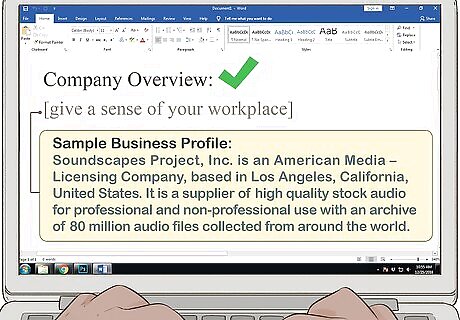
Write a description of your company or organization. This overview will be included with all job descriptions, to give a sense of your workplace. Thus, it can be written ahead of time so that it can be inserted into the template when you prepare it.
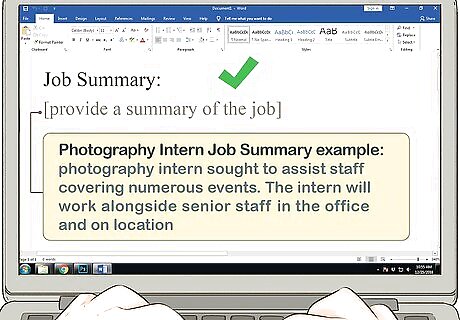
Prepare job summaries, if relevant. You can use the job description template you use for each position that you advertise by filling in the template with the information that is relevant to that position. However, if you do (or expect to do) a lot of hiring of a particular position, you might make a special template that includes a summary of that job. This will save you some time. For instance, a school might have a general template for all jobs, as well as a more specialized template for Math teachers, another for English teachers, etc.
Creating the Template
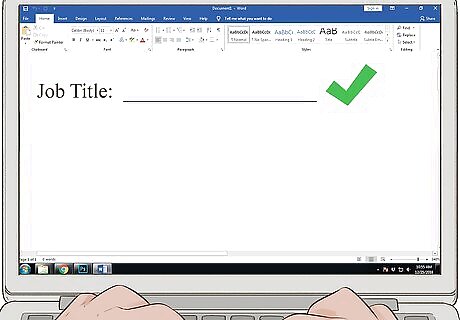
Begin with the position title. The specific job title is important because it differentiates one position from another. You will want to leave a space at the beginning of your job description template for the position title. Think about including a job title that is specific enough to differentiate the position, and help individual understand its duties, yet also broad enough to cover all potential duties of the position. For instance, “Teacher” might be too broad of a job title, while “Mathematics Teacher for Seventh Grade” might actually be too specific if the position might also occasionally need to teach math to sixth- or eighth-graders. Instead, “Middle Grades Mathematics Teacher” might be both specific and broad enough. Often, the job title is specially formatted (using a bold font, or a larger font size, etc.) in order to draw attention to it.
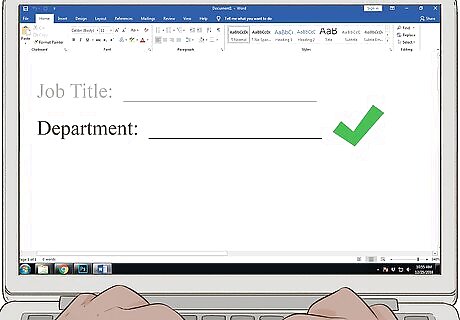
Leave room to specify the department (if relevant). If your company or organization is divided into multiple sections, then a job description should mention which department or other unit that particular position reports to. When creating a job description template, it is important to leave a place for listing the department, usually near the beginning of the document.

Define the supervisor. You may find it useful to leave a section on your template to be used for detailing the supervision of a particular position, and/or the extent to which it is supervised. This can help an individual understand who he or she would report to while performing a particular position, and the role of the position within the hierarchy of a company or organization. You may also leave a section to discuss the supervisory roles of a particular position (if relevant), if it involves managing other people. Including a section on supervision within a job description can also be a useful record when determining how to handle any conflicts that may arise regarding a particular position.
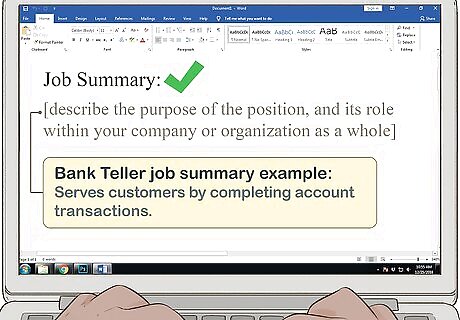
Provide a job summary section. Think of this as describing the purpose of the position, and its role within your company or organization as a whole. A job summary will briefly acknowledge the fundamentals of the position, so leave space on your job description template to answer: What do you want the job to achieve? What is its purpose? What is the primary duty of the person working in this position?
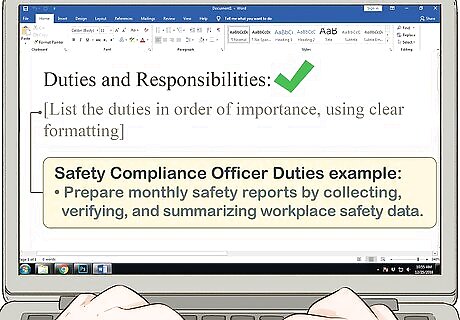
Create a space to describe essential duties and responsibilities. These might also be called “major functions” or “essential functions.” Whatever you call it, this section of a job description should provide a list of those duties that are associated with the position, no matter who fills it. List the duties in order of importance, using a bulleted list or other clear formatting. Keep in mind the following model to effectively write about the essential duties of a job: action word + subject + specific activities. For example, you might list one specific duty of a workplace safety compliance officer as “Prepare monthly safety reports by collecting, verifying, and summarizing workplace safety data.” You may also wish to include percentages describing the amount of time a position spends doing particular duties. For instance, a job description template for teachers could be used to indicate that perhaps 75% of the position is devoted to teaching duties, 15% to advising students, and 10% to serving on committees.

Consider leaving a space for “other” duties. If the exact duties of some positions at your company or organization depend upon the individuals filling them, then you might want to leave a space stating “Other duties may include….” This will give you flexibility to incorporate other duties and responsibilities based on a candidate’s experience or abilities.
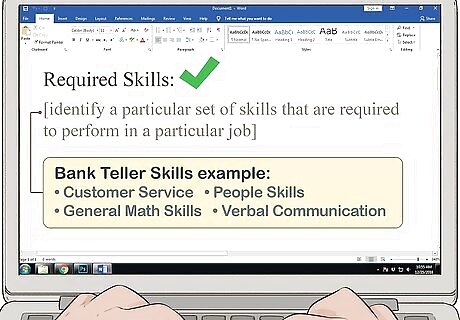
Create a required skills section. Identifying a particular set of skills that are required to perform in a particular job can help individuals understand if they have the abilities and knowledge to complete its basic duties. Examples of skills include things like “Ability to use spreadsheet software proficiently” and “Effectively manage team of 5-6 interns” Remember that skills may be “hard” (teachable skills, such as working with a particular tool, knowledge of a specific software program, or the ability to create a certain type of document or object) or “soft” (often called “people skills,” these refer to your ability to interact with others and to use emotional intelligence). Your job description template may want to reflect this by making a specific place for one, or the other, or both.

Set aside a space to list required qualifications. The qualifications section of a job description template is used to list any education, specific training, or certification that is require to perform the job. Qualifications might include: degrees earned; specific number of years of experience doing a particular kind of work; experience using specific equipment, software, etc.; and certifications required by law or other regulations in order to complete the duties of the job. You may also consider including a space on your template for minimum qualifications as well as desired qualifications. For instance, a particular position may require the knowledge and experience of a bachelor’s degree to perform its essential duties, but your company or organization may prefer that someone working in that position has a master’s degree.
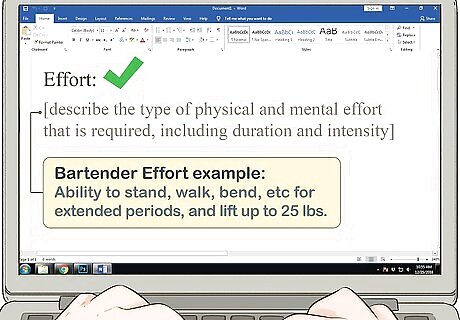
Make room to describe any special physical or mental effort the job may require. For instance, you may want a space on your job description template to describe whether or not a particular position requires things like lifting heavy objects, sitting for extended periods, performing repetitive tasks, or traveling.

Leave a section to characterize working conditions. For some positions, it is relevant to disclose working conditions. For example, some positions require working with or around things like toxic materials, potentially dangerous equipment, excessive noise, or extreme weather. If this is relevant for your workplace (or may be relevant for some positions), include a section for it in your job description template. If a particular position that you later use the template for does not have any hazardous or otherwise notable working conditions, you can write something like “normal office environment” in this section, or simply delete it from the template.
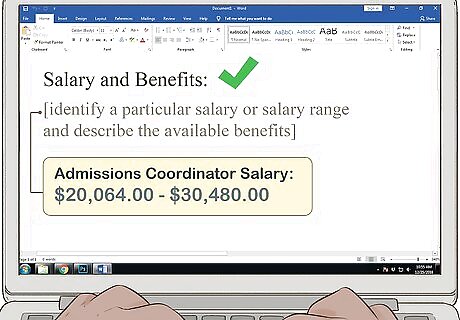
Make a space to detail the salary, benefits, or funding. If the job description template you are creating will or may be used for advertising open positions and recruiting candidates, you may also decide to include financial information. You may leave a place to identify a particular salary or salary range, a description of benefits available at your institution (whether general or position-specific), and the position’s funding source, if relevant.
Reviewing the Template

Distribute a draft of your template to managers and supervisors. Anyone who will need to use the template to create job descriptions should have an opportunity to review the template, provide feedback on it, and work together to make any improvements to it.

Use the template to input a few job descriptions that are already written. This will help you determine if you left anything out, or need to broaden the template. If you do not already have a job description written out, use the template to practice writing one, then review it together with any relevant managers.

Save the template. Keep the template in a place that is easily accessible. If many different people will need to access the template in order to write job descriptions, it needs to be readily available. For example, put the final template on a company intranet, if you have one. Otherwise, save it in a shared folder or cloud storage.
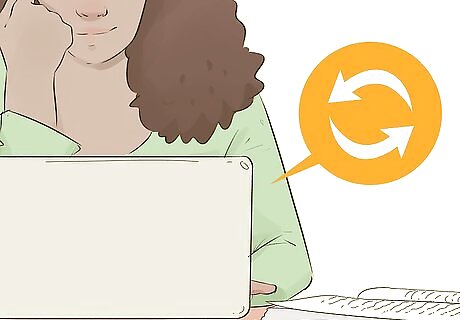
Review and update the job description template on a regular basis. As a company or organization changes and grows, its job descriptions will as well. Make a periodic (annual, biennial, etc.) review of the template a calendar item in your human resources and management meetings.




















Comments
0 comment